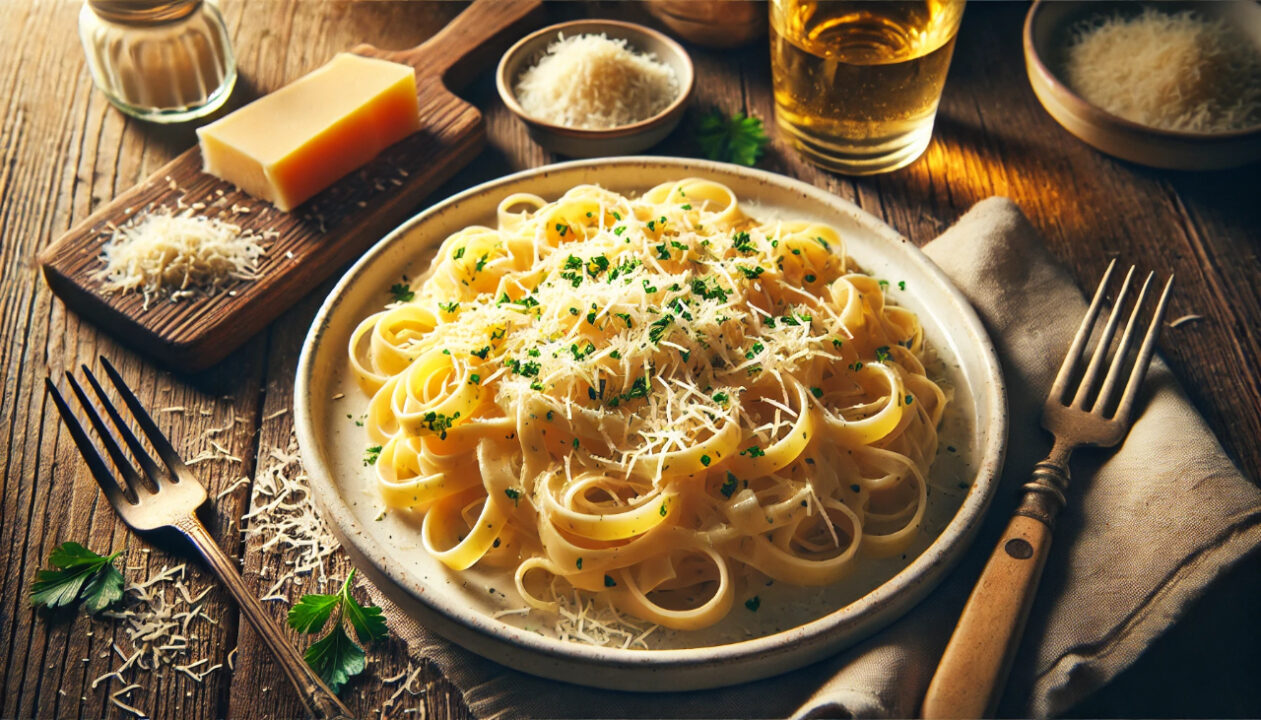Fettuccine Alfredo is a classic Italian pasta dish that has captured the hearts of food lovers around the world. Its rich, creamy sauce clings perfectly to the long, flat noodles, making it a comforting and indulgent meal that is both simple and sophisticated. In this article, we’ll explore the origins of Fettuccine Alfredo, how to make it from scratch, variations on the traditional recipe, and tips for serving and enjoying this beloved dish.
The Origins of Fettuccine Alfredo
Fettuccine Alfredo’s roots can be traced back to Rome, Italy, where it was created by Alfredo di Lelio in the early 20th century. The dish was initially conceived as a simple meal for Alfredo’s wife, who was recovering from childbirth and needed something nourishing yet easy to digest. Alfredo’s original recipe was straightforward, featuring only three ingredients: fettuccine, butter, and Parmesan cheese.
You Might Also Like: Chicken Alfredo Recipe: Creamy, Easy, and Delicious
The dish quickly gained popularity, especially after Hollywood stars Douglas Fairbanks and Mary Pickford visited Alfredo’s restaurant in Rome and fell in love with the dish. They brought the recipe back to the United States, where it became a sensation. Today, Fettuccine Alfredo is enjoyed worldwide, often with the addition of cream, garlic, and other ingredients that have become staples in the Americanized version of the dish.
How to Make Classic Fettuccine Alfredo
Creating the perfect Fettuccine Alfredo at home is easier than you might think. With just a few simple ingredients and a little patience, you can whip up a restaurant-quality dish that will impress your family and friends.
Ingredients for Fettuccine Alfredo
- 12 ounces of fettuccine pasta
- 1/2 cup unsalted butter
- 1 cup heavy cream
- 1 cup freshly grated Parmesan cheese
- 2 cloves garlic, minced (optional)
- Salt and pepper to taste
- Fresh parsley, chopped (for garnish)
Step-by-Step Instructions
- Cook the Fettuccine: Start by bringing a large pot of salted water to a boil. Add the fettuccine and cook according to the package instructions until al dente. Drain the pasta, reserving about a cup of the pasta water.
- Prepare the Sauce: While the pasta is cooking, melt the butter in a large skillet over medium heat. If you’re using garlic, add it to the butter and sauté for 1-2 minutes until fragrant. Be careful not to burn the garlic.
- Add the Cream: Pour the heavy cream into the skillet with the butter and garlic. Stir well and bring the mixture to a simmer. Let it cook for 5 minutes, allowing the sauce to thicken slightly.
- Incorporate the Cheese: Remove the skillet from the heat and gradually add the grated Parmesan cheese, stirring constantly until the cheese is fully melted and the sauce is smooth. If the sauce is too thick, add a little of the reserved pasta water until you reach your desired consistency.
- Combine with Pasta: Add the drained fettuccine to the skillet and toss it in the sauce until the pasta is well-coated. Season with salt and pepper to taste.
- Garnish and Serve: Serve the Fettuccine Alfredo hot, garnished with chopped parsley and extra Parmesan cheese if desired.
Variations on Fettuccine Alfredo
While the classic Fettuccine Alfredo recipe is delicious on its own, there are many ways to customize the dish to suit your taste. Here are a few popular variations:
Chicken Fettuccine Alfredo
Adding grilled or sautéed chicken to your Fettuccine Alfredo is a great way to incorporate protein into the meal. Simply season chicken breasts with salt, pepper, and Italian herbs, cook them until golden brown, and slice them into strips. Toss the chicken with the pasta and sauce just before serving.
Shrimp Fettuccine Alfredo
For a seafood twist, shrimp can be a delightful addition to Fettuccine Alfredo. Sauté the shrimp in butter and garlic until they are pink and cooked through, then mix them into the pasta. The combination of creamy sauce and tender shrimp is simply irresistible.
Vegetable Fettuccine Alfredo
If you’re looking to add more vegetables to your diet, consider incorporating steamed or roasted veggies into your Fettuccine Alfredo. Broccoli, spinach, mushrooms, and peas all pair wonderfully with the creamy sauce and add a burst of color and nutrition to the dish.
Fettuccine Alfredo with Truffle Oil
For a touch of luxury, drizzle a little truffle oil over your Fettuccine Alfredo just before serving. The earthy, aromatic flavor of truffle oil elevates the dish to a gourmet level and is sure to impress your dinner guests.
Tips for Perfect Fettuccine Alfredo
Making Fettuccine Alfredo may seem straightforward, but there are a few tips and tricks that can help you achieve the best results every time.
Use High-Quality Ingredients
Since Fettuccine Alfredo relies on just a few ingredients, it’s important to use the best quality you can find. Freshly grated Parmesan cheese, good-quality butter, and heavy cream will make a noticeable difference in the flavor and texture of the dish.
Don’t Overcook the Pasta
Fettuccine should be cooked al dente, meaning it should have a slight bite to it when you chew. Overcooked pasta can become mushy and won’t hold the sauce as well. Be sure to follow the package instructions and check the pasta a minute or two before the suggested cooking time to ensure it’s perfectly al dente.
Warm the Serving Dishes
To keep your Fettuccine Alfredo warm for longer, consider warming your serving dishes before plating. This can be done by placing the dishes in a low oven for a few minutes or filling them with hot water and then drying them just before serving.
Serve Immediately
Fettuccine Alfredo is best enjoyed right away while the sauce is still hot and creamy. If you need to reheat leftovers, do so gently over low heat, adding a splash of cream or milk to help revive the sauce.
Pairing Fettuccine Alfredo with Wine
Wine can enhance the dining experience when enjoying Fettuccine Alfredo. The rich, creamy sauce pairs well with a variety of wines, depending on your personal preferences.
White Wine Pairings
A crisp, dry white wine such as Chardonnay, Sauvignon Blanc, or Pinot Grigio complements the creaminess of the Alfredo sauce without overpowering it. The acidity in these wines helps to cut through the richness of the dish, creating a balanced and enjoyable pairing.
Red Wine Pairings
If you prefer red wine, opt for a light-bodied red such as Pinot Noir or a fruity Merlot. These wines have soft tannins that won’t clash with the delicate flavors of the Alfredo sauce.
Sparkling Wine
For a festive touch, consider serving Fettuccine Alfredo with a glass of sparkling wine or Champagne. The bubbles add a refreshing contrast to the creamy sauce, making it an excellent choice for special occasions.
Serving Suggestions for Fettuccine Alfredo
Fettuccine Alfredo is a versatile dish that can be served as a main course or as part of a larger meal. Here are some ideas for what to serve alongside your Fettuccine Alfredo.
Salads
A fresh, crisp salad is the perfect accompaniment to Fettuccine Alfredo. Consider a simple Caesar salad, a mixed green salad with a tangy vinaigrette, or a Caprese salad with tomatoes, mozzarella, and basil.
Bread
A slice of warm, crusty bread is perfect for mopping up any leftover Alfredo sauce on your plate. Garlic bread, focaccia, or a simple baguette are all excellent choices.
Vegetables
Steamed or roasted vegetables make a great side dish for Fettuccine Alfredo. Asparagus, green beans, and Brussels sprouts are all delicious options that add color and nutrition to your meal.
Dessert
Finish your meal with a light and refreshing dessert to balance the richness of the Fettuccine Alfredo. A fruit sorbet, lemon tart, or a simple bowl of fresh berries can provide the perfect ending to your dinner.
Fettuccine Alfredo: A Comfort Food Classic
Fettuccine Alfredo has stood the test of time as a beloved comfort food that is both indulgent and satisfying. Its creamy, cheesy sauce and tender pasta make it a go-to dish for cozy nights in, special occasions, and everything in between. Whether you stick to the classic recipe or experiment with different variations, Fettuccine Alfredo is sure to bring a smile to your face and warmth to your soul.
FAQs
What is the best cheese to use in Fettuccine Alfredo?
The best cheese for Fettuccine Alfredo is freshly grated Parmesan cheese. It melts beautifully into the sauce and adds a rich, savory flavor.
Can I make Fettuccine Alfredo ahead of time?
While Fettuccine Alfredo is best served fresh, you can prepare the sauce ahead of time and store it in the refrigerator. When ready to serve, reheat the sauce gently and toss it with freshly cooked pasta.
Is Fettuccine Alfredo gluten-free?
Traditional Fettuccine Alfredo is not gluten-free because it is made with wheat-based pasta. However, you can make a gluten-free version by using gluten-free fettuccine or another gluten-free pasta.
Can I use milk instead of cream in Fettuccine Alfredo?
You can use milk instead of cream, but the sauce will be less rich and creamy. To compensate, you might want to add a bit more butter or a thickening agent like flour or cornstarch.
How can I thicken Fettuccine Alfredo sauce?
If your Alfredo sauce is too thin, you can thicken it by simmering it for a few more minutes, adding more grated Parmesan cheese, or stirring in a small amount of cornstarch mixed with water.
Can I freeze Fettuccine Alfredo?
Fettuccine Alfredo can be frozen, but the texture of the sauce may change slightly upon reheating. If you do freeze it, reheat it slowly over low heat and consider adding a little cream or milk to restore the sauce’s consistency.





